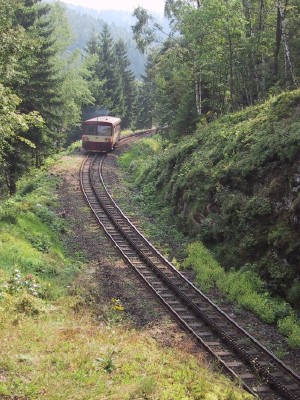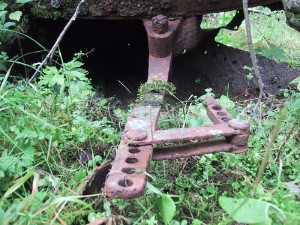© F. Wolf
The following article on the accident of the locomotive (classification 38.2605) in 1945 originally was intended as a private study. Because of the increasing interest in the rack mountain railway line Tanvald – Polubny (today Tanvald – Harrachov) during the last years this contribution was published on the web.
Pretty well I remember the crashed locomotive with tender lying on the slope beneath the rail section Prichovice (Prichovitz) - Dolni Polubny (Unterpolaun). As a boy aged 4 to 5 I frequently passed the place of the accident when going by car at the end of the forties. I especially remember some details concerning the removal of the wreck in the year 1948. Even later-still at the end of the fifties - I could see the remnants of the locomotive when passing by bike.
Notes on the removal of the wreck
55 years later I remember the following details:
one day in the year 1948 a temporarily constructed somewhat small crane with a hand-operated (pulley) block appeared - as far as I remember - on the left side of the road beneath the place of the accident (when going uphill from Tanvald to Prichovice). Because of its “three legs”-construction this crane resembled the original station crane in Tanvald-Sumburk (this crane was replaced by the well-known gantry crane in the fifties, which also became disassembled recently in 2005 on the occasion of the reconstruction of the station building). On the other side of the road (beneath the slope with the locomotive) parts of the locomotive and tender were already scattered. I still wonder at the construction of the crane on the left side of the road, but looking closely at the border of the road on the photos, you can realize that it was impossible to build up the crane on the right side because of the deep ditch (fig.1).
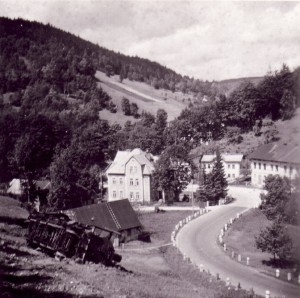 Fig.1 Position of the locomotive with background
Fig.1 Position of the locomotive with backgroundOn the next occasion - a couple of days later - there was a platform truck (in my opinion a Tatra 111 or somewhat like this) near the crane and a driving wheel and axle set was hanging on the crane hook. Later I saw this car passing Tanvald, loaded with wheel and axle sets. The salvage operations did not take much time. To my astonishment some parts remained on the slope - which could well be noticed from the road. A corroded smoke box part, a frame part with undercarriage for the boiler and various metal parts scattered over the slope could easily be made out. It is likely that already at that time there was only an interest in materials of high quality or spare parts that could still be used. The place where the locomotive had left the rails could also be recognized after years - obviously the railway embankment on the accident section had been repaired rough and ready.
On-the-spot investigations
I have never forgotten the incident concerning the locomotive. When returning to Tanvald in the nineties, I wanted to visit the place of the accident again. I wondered whether the locomotive had been removed meanwhile - during the long period of 56 years. For this project I prepared myself a bit. I gathered information on the locomotives series 38 (former classification P8) and their measurements (on the web, see 1.2 - fig.2).

Fig. 2 Dimensions of the P8 – locomotive
This type of locomotive apparently was not a rare specimen. From 1906 to the end of World War I about 2350 of this kind had been built, the entire production till 1923 amounted to more than 3500. The locomotives were in operation till about 1974.
This type of locomotive could easily be recognized by the irregular arrangement of the wheel and axle sets: while both the front axles were close to each other (1880 mm, the diameter of the wheel 1750 mm) the rear axle with a distance of 2700 mm was approximately beneath the fire box (this is well noticeable on photos of that time or fig.2)
For reasons of interest some further details: diameter of carrying wheels: 1000 mm, top speed : 100 km/h, power output: 1180HP, weight: 78.2 t.
I carried out my plan not until 2001. In the summer of that year I walked from Tanvald via Dolni Polubny to the known place. As the road routing had been changed meanwhile and the place itself was partly covered with trees (the small house had vanished as well) I had to search for a while with the help of my photos (1.1) – (fig.1; fig.3; fig 3a).
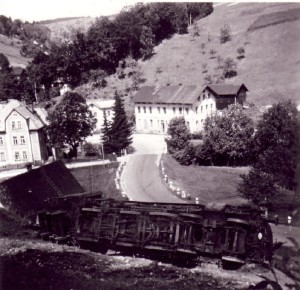
Fig. 3 Position of the locomotive
Coming from the road I climbed up to the railway track - for evident reasons it seemed much more exhausting to me than decades ago. I started the search at the rails in the bend - the place where the locomotive left the rails can easily be made out even today; the railway embankment is still slightly different from the original shape (fig. 4).
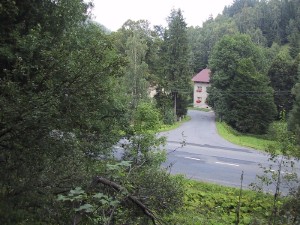
Fig. 4 Place of derailment (in front of the rail-car)
The way of the locomotive on the railway embankment to the place where it came to a stop cannot be determined any longer because of the dense growth. After some roaming about I found the first object (fig. 5). I am not sure what it is - maybe a former part of the fire box or a part of the tender.
A more interesting object turned up somewhat later (fig.6) - it looks like some moving part or a part of the steam reversing gear. Experts on P8-locomotives could probably identify it.
I continued my way along an assumed line connecting both objects, in order to reach the former front section of the locomotive. Besides a corroded part of the fire smoke I remembered remnants of frame parts and the boiler undercarriage jutting out from the meadow. But that day I only found a piece of electric wire as it was used on the surface of steam locomotives and tenders. It consisted of some insulated wires in a steel pipe - rusted through after so many years.
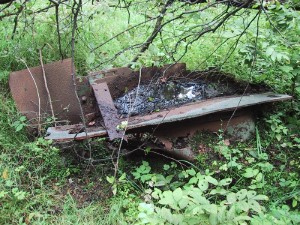
Fig. 6 Object no. 2
In the evening I studied the diagram of the locomotive once more -the locomotive obviously was longer than I had assumed when walking through the difficult conditions of the ground. The following day I searched deeper in the dense growth. At first a piece of structural iron (in the shape of a flat V) appeared (fig.7).
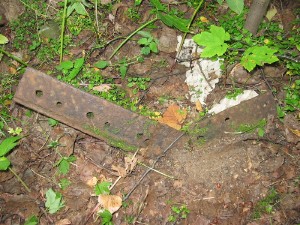
Fig. 7 Object no. 3
Only some distance ahead I discovered the object strikingly jutting out of the former meadow about sixty years ago (fig.8). Judging by its form it could be the undercarriage of the smoke box or boiler.
Maybe that those two parts are attached to another part that could be located subterraneanly.
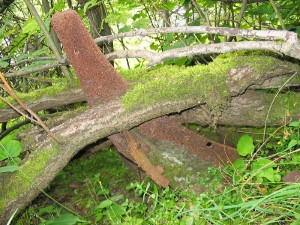
Fig. 8 Object no. 4
Due to the dense growth during the summer nothing else could be found right away. But it is possible that more parts would turn up in a minute “archaeological” investigation.
It would be interesting to find out which parts of the locomotive are concerned. A small number of P8-locomotives has been left - maybe someone could identify the described components.
Summary
The remnants of the locomotive have never been removed completely. It is surprising that some parts still were traceable after several decades.
At that time the accident with the locomotive meant a sensation for the area around Tanvald. I myself heard some versions of how the accident had occurred. According to the latest exact investigations they altogether were not true but were products of story-tellers’ imagination.
Perhaps the remnants of the locomotive could be saved for future generations…
List of references
(1.1) Photos of that time (in my possession)
(1.2) Web –www.museumslok.de
(1.3) Kniha o železnici; V. Mareš, E. Holan, 1936 K. Synek, Praha
Further interesting literature and sources:
(2.1) web - Železniční společnost Tanvald
(2.2) web – albico.cz
(2.3) Die Zackenbahn; Herausg. K.Ch.Kasper; 2003; ISBN 3-930567-17-2
(2.4) 100let trati Tanvald – Kořenov – Harrachov; Saxi Special; 2002
(2.5) Zpráva o pátrání po příčině násilné smrti W. Bienerta, strojvůdce státních drah, k níž došlo dne 5. srpna 1945 v Dolním Polubném; Tomáš Gál; Železniční společnost Tanvald, 2005
FW-HH, March 2006
